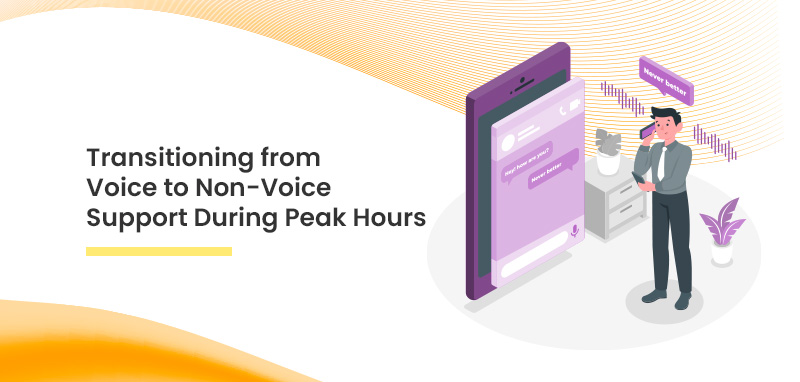Transitioning from Voice to Non-Voice Support During Peak Hours
In today’s fast-paced customer service environment, managing call volumes efficiently is a top priority for call centers. During peak hours, when customer demand surges, the traditional voice support model can struggle to keep up, leading to long wait times, frustrated customers, and overwhelmed agents. One effective strategy to alleviate the pressure on voice channels is transitioning customers to non-voice support options like live chat, email, or self-service. Not only does this help manage high call volumes, but it also enhances customer satisfaction by offering faster, more flexible service options.

Understanding the Need for a Multi-Channel Approach
With the rise of digital communication, customers now expect seamless support across various platforms. While voice support remains essential, it’s not always the most efficient channel, especially when the demand spikes. Voice calls are time-sensitive and require one-on-one interaction, which can be resource-intensive during busy periods. Non-voice channels like live chat, email, or even social media offer more flexibility. They allow agents to handle multiple queries simultaneously, leading to faster resolutions and better use of resources.
Transitioning from voice to non-voice during peak hours not only helps reduce call wait times but also enhances the overall customer experience. Customers who may not want to wait in a queue for voice support can quickly resolve their issues via chat or email, making the entire process more convenient for both parties.
Preparing Your Customers for the Transition
The first step in transitioning from voice to non-voice support is educating your customers about the available options. Many customers default to voice calls because they may not be aware of how efficient non-voice channels can be. A simple prompt when customers are on hold, such as “Don’t want to wait? Try our live chat or email support,” can encourage them to explore these alternatives.
Incorporating an automated interactive voice response (IVR) system that offers options like “Press 1 for live chat link via SMS” or “Press 2 to leave a message via email” can further nudge customers toward non-voice channels. Similarly, directing customers to FAQs or self-service portals when their issue is straightforward can significantly reduce voice traffic.
Another crucial aspect is ensuring that the transition to non-voice channels is seamless. Customers should be able to shift from voice to chat or email without repeating their issue multiple times. Implementing a CRM system that consolidates all customer data, no matter the communication channel, ensures agents have the context they need to provide efficient support.
Training Your Agents for Multi-Channel Support
Successfully transitioning from voice to non-voice during peak hours requires a versatile team of agents who are skilled in both voice and text-based communication. Non-voice interactions demand a different skill set—agents must be able to convey empathy and clarity through written words, while multitasking efficiently across multiple conversations.
Investing in regular training that focuses on improving agents’ written communication skills is essential. Additionally, agents should be trained to handle complex queries via non-voice channels with the same care and attention they give to voice calls. For instance, live chat agents should be able to respond quickly, using concise but helpful language, while maintaining a professional and empathetic tone.
The Role of Automation in Non-Voice Channels
Automation plays a pivotal role in managing peak-hour transitions to non-voice channels. Chatbots, for instance, can handle basic queries and guide customers through common troubleshooting steps, reducing the workload for human agents. These AI-powered bots can be programmed to escalate more complex issues to a live agent, ensuring that customers receive the help they need without overwhelming the team.
Email automation, too, can help streamline non-voice support during peak hours. Automated replies can acknowledge receipt of the customer’s query and provide an estimated response time, helping set expectations and improving the customer’s overall experience.
Monitoring and Optimizing the Transition Process
It’s essential to monitor the effectiveness of your voice-to-non-voice transition strategy during peak hours. Key performance indicators (KPIs) such as first response time, resolution time, and customer satisfaction should be regularly analyzed to ensure that non-voice channels are delivering the expected results. Customer feedback surveys can provide valuable insights into areas of improvement, whether it’s better training for agents or optimizing the automation process.
Conclusion
Transitioning from voice to non-voice support during peak hours is a smart, strategic move for call centers looking to manage high call volumes while maintaining service quality. By offering customers alternative support options like live chat, email, or self-service, you not only reduce the pressure on voice agents but also enhance the overall customer experience. Properly trained agents, effective automation tools, and continuous monitoring are the key components that make this transition seamless and successful.
